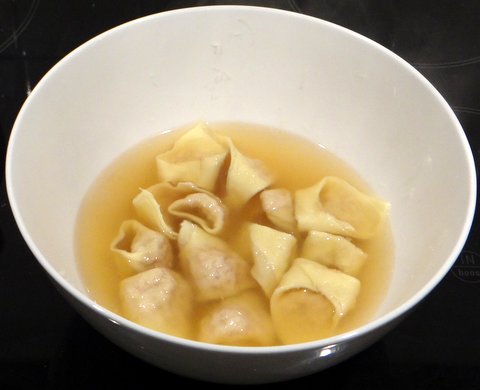
Tortellini in brodo (tortellini in broth) is a classic Christmas dish from Bologna. The tortellini need to be so small that you can eat them in a single bite, together with the broth. It is quite a bit of work to make them as well as the broth from scratch, but certainly worth it. You can make the broth and the tortellini the day before, in fact my advice would be to do that. Officially you need a capon (neutered rooster) to make the broth, but a plump farm chicken will do.
Tortelli and tortellini are the typical stuffed pasta shapes from Emilia-Romagna, the region around Bologna. The word “tortellino” is derived from “torta” (tart), in the meaning of something made from dough with stuffing inside. “Tortello” is the diminutive of torta and means small tart. “Tortellino” is the diminutive of tortello and is even smaller.
In 1974 the official recipe for tortellini has been deposited with the Bologna chamber of commerce. The dough has to be made from eggs and flour and rolled out to a thin .6 mm (about 1/40 inch) and the stuffing needs to be made from pork loin, prosciutto, mortadella, parmigiano reggiano, egg, and nutmeg. The only variation is in the quantities of the ingredients. Some recipes specify equal amounts of pork loin, mortadella and prosciutto. However if the mortadella and prosciutto are salty, this mixture can end up being too salty. I recommend to use more pork loin and add a bit of salt when needed.
Ingredients
For about 6 servings
3 eggs
300 grams (2 cups) 00 flour
For the stuffing
150 grams (6 oz) pork loin
50 grams (2 oz) prosciutto di Parma, chopped
50 grams (2 oz) mortadella di Bologna, chopped
50 grams (2 oz) freshly grated parmigiano reggiano
1 egg
1 Tbsp butter
nutmeg to taste
salt to taste
For the broth
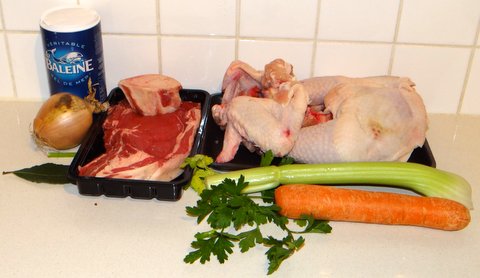
1 capon or plump farm chicken (about 2 kilograms or 4.5 pounds), cut into pieces (it is OK to remove the breast and reserve it for another use)
about 500 grams (1 pound) well-marbled beef with bone, or with a separate piece of marrow
1 carrot
1 celery stick
fresh parsley
1 onion
1 ripe tomato
1 bay leaf
For serving
salt to taste
freshly grated parmigiano reggiano
Preparation of the stuffing
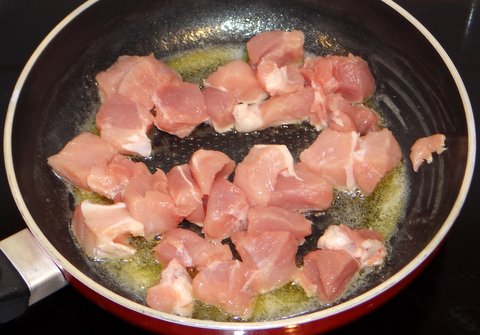
Cut the pork loin into cubes. Heat 1 Tbsp butter in a small frying pan and add the pork loin.
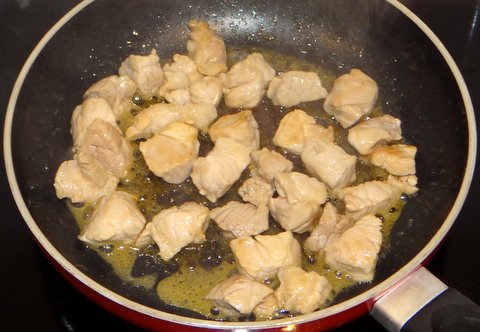
Sauté on all sides over high heat until slightly golden.
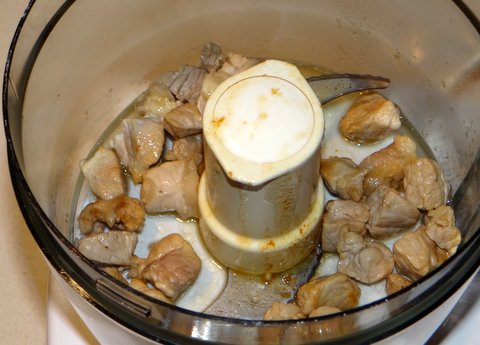
Transfer the meat and all of the cooking juices to a food processor or blender.

Add an egg, mortadella, prosciutto, and nutmeg.
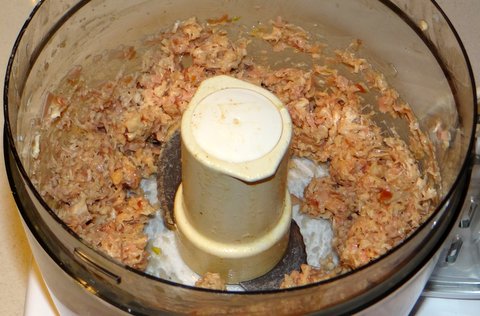
Process until chopped fine but not pureed.
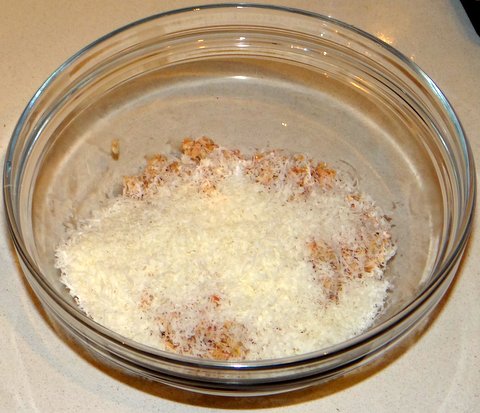
Transfer to a bowl. Add cheese and stir until homogeneous. Taste and adjust the seasoning with salt.
(If you are worried about tasting raw egg, bring a small saucepan of water to a boil. Reduce the heat to a simmer and add a small ball of the stuffing. Cook for 30 seconds or until cooked through. Taste the ball and adjust the seasoning if needed.)
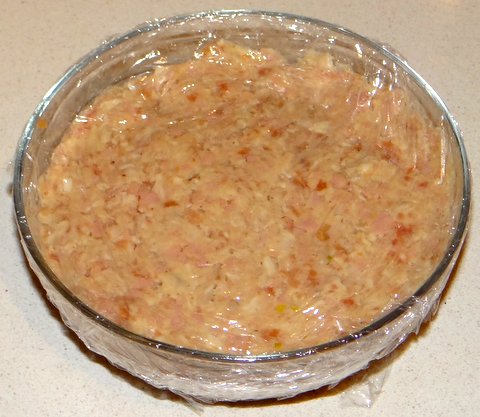
Cover tightly with plastic wrap and refrigerate until needed (overnight is fine).
Preparation of the brodo
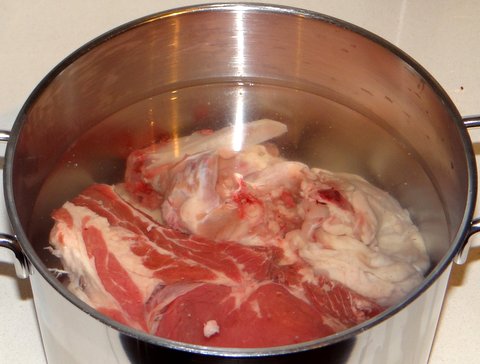
Soak the chicken and beef in cold water to remove any traces of blood. This helps to make a clear broth.
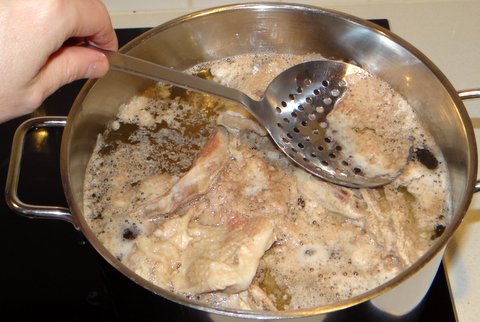
Put the chicken and beef in a stock pot and cover with cold water. Bring to a boil and remove the scum that will rise to the surface.

Reduce the heat and simmer for 2 hours.
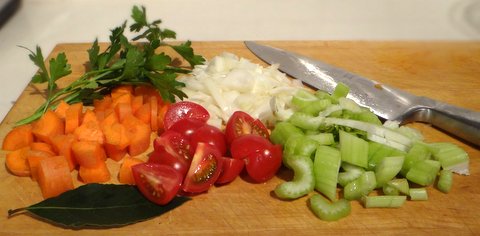
Chop the vegetables for the stock.
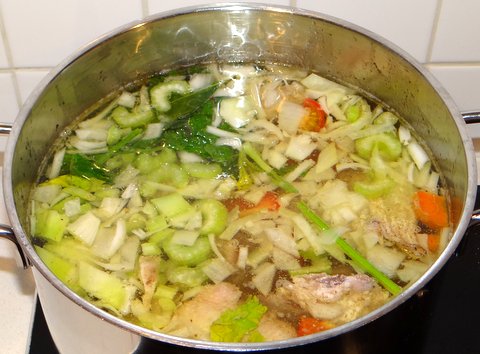
Add the vegetables after two hours.
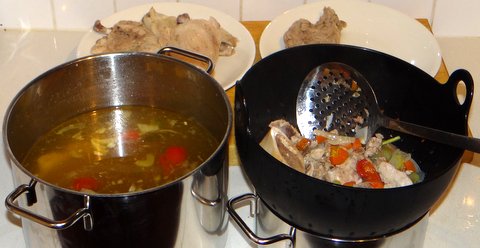
Drain the broth. Reserve the chicken if you like to eat it warm with salsa verde or cold in a salad.
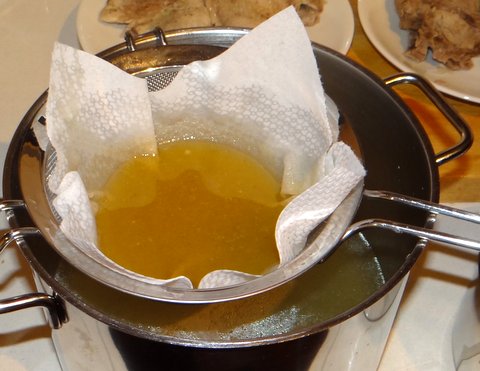
Sieve the broth through cheese cloth or kitchen paper. The broth needs to be very clear for this recipe.
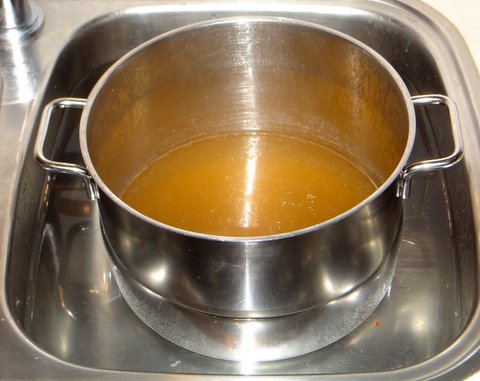
Let the broth cool quickly by submerging the stockpot in (ice) cold water and stirring. Let it cool further in the refrigerator.
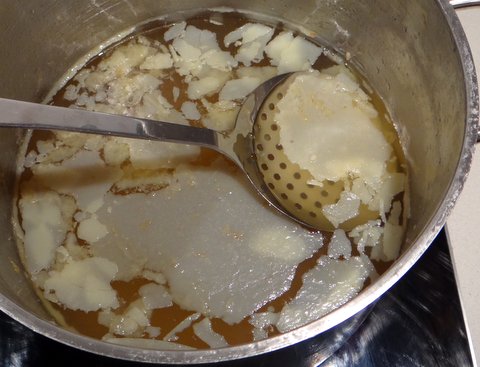
When the stock is completely cold, a layer of fat will form on top. Remove this with a slotted spoon.
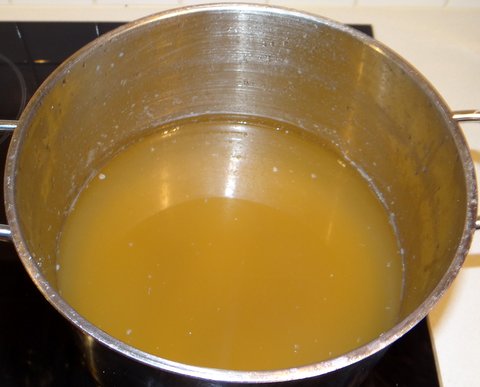
You will now have a very clear broth.
How to make the tortellini
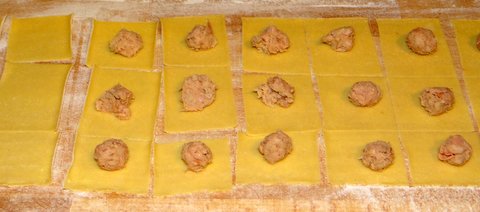
Make fresh pasta dough from the eggs and flour. I use 00 flour for tortellini to make them feathery light.
Roll out the dough to a thickness of .6 mm (1/40 inch). Cut it into squares with a size of 3.5-4 cm (1.5″). Put a small piece of filling (about 1/2 tsp) on the center of each square.
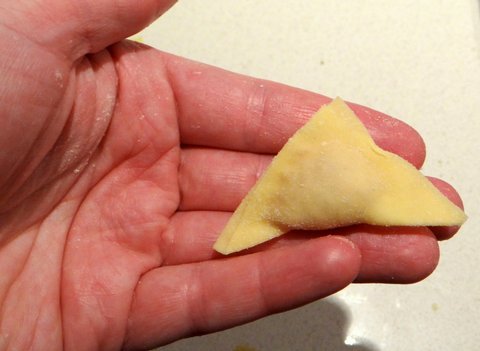
To shape tortellini, fold a square in half diagonally and pinch to seal the edges. Make sure there is no air trapped inside. Flatten the stuffing a bit if needed.
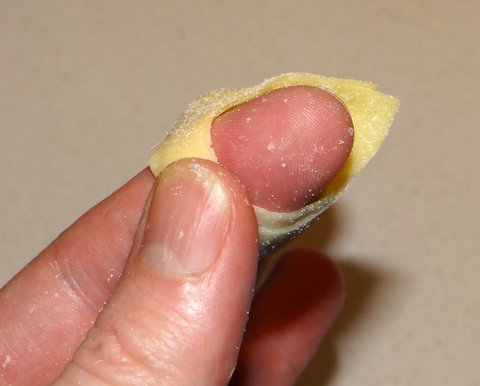
Fold the triangle around your index finger, pressing the ends together with your thumb.
If the dough has become too dry, you can moisten the edges with a bit of water.
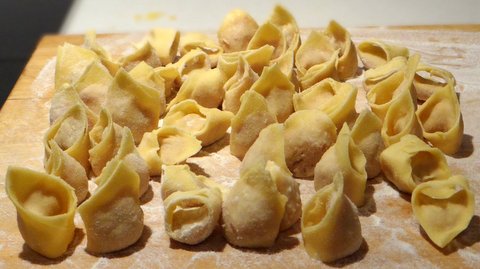
Repeat until you have used up all of the filling. Turn the tortellini if needed to let them dry on both sides. Try to avoid getting too much flour on them, because all that flavor will cloud the broth later.
You can store the tortellini overnight at cool room temperature, covered with a kitchen cloth.
How to cook

Bring the broth to a boil. Add salt to taste, but not too much. Add 1 tortellino and cook for 3 minutes or so. Taste it together with a bit of the broth. The broth and the tortellino should have a similar level of saltiness. Add more salt to the broth if needed. (Adding more salt to the tortellini is not possible at this point, that is why you should make sure you taste the stuffing before you put it into the tortellini and also not to add too much salt to the broth before tasting it together with a cooked tortellino.)
As soon as the saltiness of the broth has been calibrated, bring back to a boil and add all of the tortellini. Cook for about 3 minutes (depending on how long the tortellini have been drying).

Serve the tortellini in bowls, just covered by broth, and sprinkled with some freshly grated parmigiano. Service with spoons to eat the tortellini together with the broth.
Wine pairing
Tortellini in brodo pair well with a full-bodied dry Italian white wine such as Verdicchio dei Castelli di Jesi, or a light Italian red wine, or a dry red Lambrusco di Sorbara. The latter is most classic as it is from the same region, but it has to be good quality very dry Lambrusco (secco).
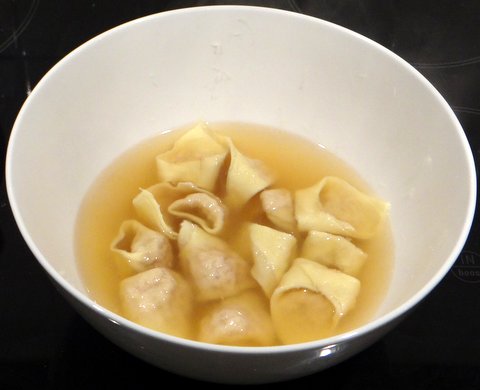
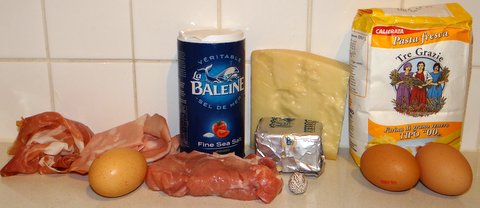
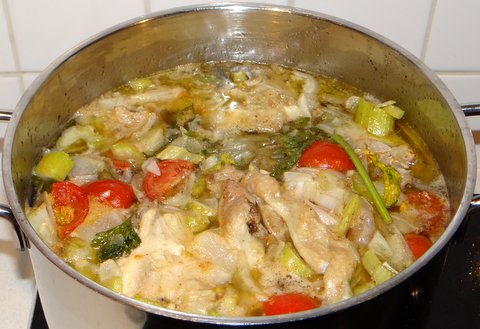

I love these… and I especially like your filling.
LikeLike
Thanks. It’s the official recipe 🙂
LikeLike
A lot of work, but a beautiful, perfect dish! Thank you!
LikeLike
Thank you 🙂
LikeLike
These look amazing. When we were in Italy in the Parma region I would order tortellini and get what looked like ravioli. But I guess it could be a generic name for stuffed pasta. It was amazing regardless of what they called it. 🙂
LikeLike
It’s amazing how Italians can be very specific about how a recipe should be (i.e. exactly like their (grand)mother made it), compared to how sloppy they can be with naming things. You are probably right it was generic. In the Parma region the main shape for stuffed pasta is tortellini, and thus everything is called tortellini or tortelli (for the slightly bigger ones). Ravioli are much easier and faster to make. They look slightly more boring, but there is hardly a difference in mouthfeel.
LikeLike
That is so true. I never did get a tortellini shape but the flavours were out of this world. And the recipes were all unique.
LikeLike
We’re on parallel paths, my friend. I’ll be posting a recipe for Mom’s brodo and another for her cappelletti, which she served in her brodo on special occasions. I’ve seen recipes where tortellini filling is made with mortadella and.or prosciutto but never tasted it. In fact, you’re the first person I “know” that has made and tried it. If you like it, this recipe must be a winner. Thanks for sharing.
LikeLike
I like this filling very much, perhaps even more with a simple sauce of burro e salvia.
It’s always interesting to me how Italians know the food from their own home town or region very well, but not so much from other regions. It’s probably from growing up with that kind of food and being used to it that it is preferred over the food from other regions, even though the differences are quite small as seen by an outsider. In Bologna this is the ‘only’ filling. I’m looking forward to your mom’s brodo and cappelletti.
LikeLike
Looks great! You have been busy this week! This one does look like a bit of effort…
LikeLike
You haven’t seen all of it yet, more to come 🙂
LikeLike
Well, you know where I come from and I am the biggest tortellini snob on the planet. I think there are about 12 people left in Bologna who can make tortellini the way god intended, and one is my mother. My only new year’s resolution this year is to learn to make them the way she makes them before it’s too late. Wish you could taste them. Yours look pretty close! Well done and Buon Anno
LikeLike
Grazie Claudia, ti auguro anche un buon anno!
I’ve learned how to cook Italian from the books of Biba Caggiano (from Bologna) and had some pointers on these tortellini from my Italian teacher (also from Bologna) so perhaps that helped 🙂
I know that I didn’t do the shape properly, but I wonder if anyone with a blindfold would have noticed 😉
So far all the people from Bologna I’ve talked to about tortellini have stated that their mom is the champion. I haven’t talked to 12 people yet though… 😉
Please share what you learn from tua mammina with us!
Next time I go to Bologna I’ll have to ask you which restaurant or trattoria to go to to taste the real thing…
LikeLike
Incredible attention to detail! And stuffed pasta is one of the few things i can get my youngest to eat…
LikeLike
If you find this a bit daunting, you can start by just making ravioli with this stuffing, and serving them with butter and sage or a bolognese sauce. That’s divine as well!
LikeLike
Hi there, wanted to let you know I nominated you for the Sunshine award. If you are interested click here for details. http://ourgrowingpaynes.wordpress.com/2013/01/02/sunshine-award/
LikeLike
Thanks so much 🙂
LikeLike
You’re welcome. I know not all will go through the process so I look at it as an opportunity to give fellow bloggers a shout out. 🙂
LikeLike
Another beautiful post with step by step pics, Stefan. It looks and sounds delicious. One of these days I’m going to make some homemade pasta. I haven’t made it in years but it is always so good when I do. Maybe I’ll give this a try. It seems well worth the effort.
LikeLike
It definitely is! Making homemade pasta is especially worth the effort with stuffed pasta, since nothing you can buy in a store gets even close. Part of the reason is technical: they need to include more filler such as breadcrumbs to give it a longer shelf life.
LikeLike
Very nice post, If I might suggest the flowing: you should fold the tip of the tortellini over the filling. They seem to be have been folded the wrong way around. and the trick is to made them as small as possible. Female fingers are better than male ones , eheheh. Anyway nice trial!
LikeLike
Thanks, Emilia. I knew that I wasn’t folding them exactly right, and despite watching a number of YouTube videos I didn’t get the hang of it.
What size do you think the square of dough is supposed to be? Most sources I have found say between 3.5 and 4 cm.
LikeLike